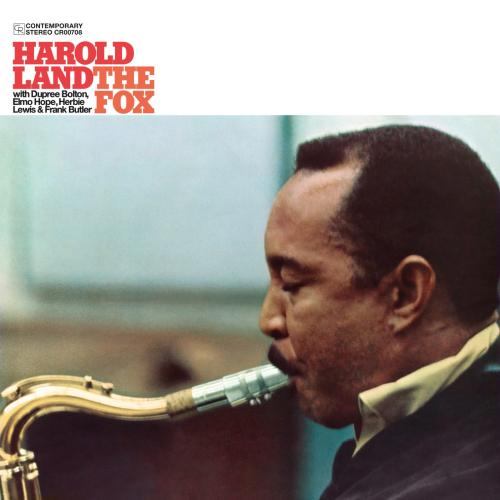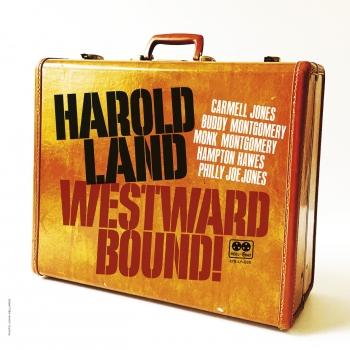
The Fox (Remastered 2024) Harold Land
Album Info
Album Veröffentlichung:
1969
HRA-Veröffentlichung:
12.04.2024
Das Album enthält Albumcover
Entschuldigen Sie bitte!
Sehr geehrter HIGHRESAUDIO Besucher,
leider kann das Album zurzeit aufgrund von Länder- und Lizenzbeschränkungen nicht gekauft werden oder uns liegt der offizielle Veröffentlichungstermin für Ihr Land noch nicht vor. Wir aktualisieren unsere Veröffentlichungstermine ein- bis zweimal die Woche. Bitte schauen Sie ab und zu mal wieder rein.
Wir empfehlen Ihnen das Album auf Ihre Merkliste zu setzen.
Wir bedanken uns für Ihr Verständnis und Ihre Geduld.
Ihr, HIGHRESAUDIO
- 1 The Fox (Remastered 2024) 05:32
- 2 Mirror-Mind Rose (Remastered 2024) 06:38
- 3 One Second, Please (Remastered 2024) 05:49
- 4 Sims A-Plenty (Remastered 2024) 06:14
- 5 Little Chris (Remastered 2024) 05:07
- 6 One Down (Remastered 2024) 07:22
Info zu The Fox (Remastered 2024)
Am 12. April wird vom Meister des Tenorsaxofons, Harold Land, das ursprünglich 1960 veröffentlichte Album „The Fox“ erscheinen, welches bei Insidern Kultstatus genießt. Das Album zeigt ihn als Bandleader und entstand unter Mitwirkung des großartigen Pianisten Elmo Hope sowie des brillanten und schillernden Trompeters Dupree Bolton, der selbst nur wenige Aufnahmen hinterließ. Bei diesem Hard-Bop-Album spielte Herbie Lewis Bass und Frank Butler Schlagzeug, produziert wurde es von David Axelrod. Harold Lands expressiver Sound und improvisatorischer Einfallsreichtum sind legendär. Der amerikanische Jazz-Saxophonist entwickelte einen persönlichen und modernen Stil, sein Ton war stark und emotional, deutete aber auf eine gewisse introspektive Zerbrechlichkeit hin. So zeigt beispielsweise das überraschend bewegende, honigsüße „Mirror Mind Rose“ die Bandbreite von Lands virtuosem Spiel und ist eine außergewöhnliche Übung in Ausdruck und Zurückhaltung.
Bereits mit 16 Jahren begann Harold Land Saxofon zu spielen. Mitte der 50er Jahre schloss er sich dem Clifford Brown-Max Roach Quintett an, mit dem er an der Spitze der Hardbop/Bebop-Bewegung stand. Aber schon bald musste Land aus persönlichen Gründen die Band verlassen und seine Karriere erlitt durch die Übersiedelung nach L.A. einen Einschnitt. Dort spielte er u.a. mit Curtis Counce und war Bandleader einer eigenen Formation. Zu Beginn der 70er-Jahre wurde es etwas still um Land, bevor er von 1975 bis 1978 mit dem Trompeter Blue Mitchell zusammen arbeitete. In den 80er-Jahren bis in die frühen 1990er Jahre war er regelmäßig mit den Timeless All Stars zusammen. Harold Land war Professor an der University of California, Los Angeles.
Harold Land, Tenorsaxophon
Dupree Bolton, Trompete
Elmo Hope, Klavier
Herbie Lewis, Bass
Frank Butler,Schlagzeug
Digital remastered von Bernie Grundman
Harold Land
A soft-spoken man whose personality rarely suggests the incandescence of his instrumental sound, Harold Land was born in 1928 in Houston, Texas. The family moved to San diego when he was five; it was during his high school years there he became interested in music and in 1945 was presented with his first saxophone.
His early influences were the big, warm tones of Coleman Hawkins and Lucky Thompson; later Charlie Parker's new concepts helped determine his direction. He was just out of high school when a bass player named Ralph Houston helped him join the Musician's Union.
After working in Houston's band, he spent a long while soaking up experience at the Creole Palace where a small combo, usually five or six pieces, was led by Froebel Brigham, a trumpeter. "During both these jobs my closest friend and musical colleage was the drummer, Leon Petties," Harold remembers. "We played the floor show and jazz sets too. Sometimes men like Hampton Hawes, Teddy Edwards and Sonny Criss came down from Los Angeles and worked with us--this provided a great stimulus."
Later, Land and Petties went on the road for about a year, first with a group led by guitarist Jimmy Liggins, and then in the band of his celebrated brother, Joe "Honeydripper" Liggins. Harold recalls this rhythm-and-blues experience as valuable in rounding out his musical education. After putting in additional time back at the Creole Palace, Harold decided in 1954 to try his luck in Los Angeles. For several months there were various odd jobs, none very rewarding.
The turning point came one night when Clifford Brown took his combo-leading partner, Max Roach to hear Harold play in a session at Eric Dolphy's house. "Eric had known me since the San Diego days, and after I moved to L.A. we became good friends," Harold says. "He was beautiful. Eric loved to play anywhere, any hour of the day or night. So did I. In fact, I still do."
The unofficial audition led to Harold's being hired by Brown and Roach. As jazz night club audiences around the country were exposed to the freshness and vitality of Land's playing, he seemed to be well on his way; but in 1956 he had to leave the quintet and return to Los Angeles because of illness in the family.
If, during the balance of the 1950s, he had continued to tour with name groups, there is little doubt that his reputation would have been established sooner and much more firmly on an international level.
"Harold's been one of the finest tenor players I've heard and I have hardly heard a write-up about what this man has been doing through the years. In New York he would have gotten more." (Buddy Collette) Source: LEONARD FEATHER, from the liner notes, The Fox, 1959, Contemporary.
Dieses Album enthält kein Booklet











